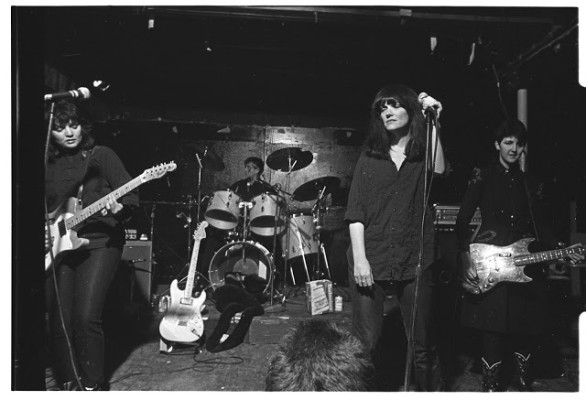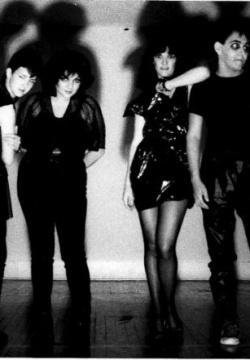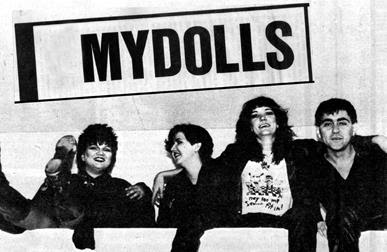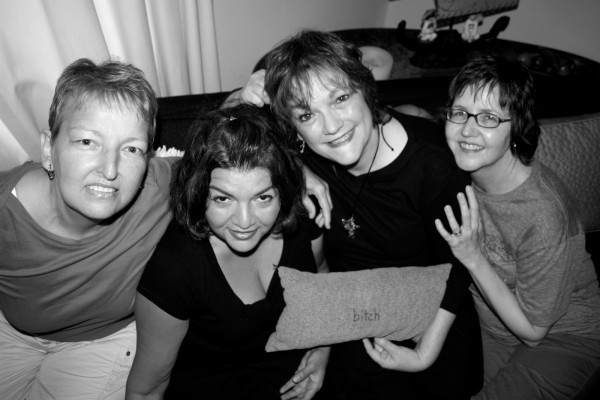Shotgun Seamstress : (Maximum RockNRoll) A World of Her Own: An Interview with Mydolls

Printed in Maximum RockNRoll #356 January 2013, ANTIGRAVITY October 2012 and Fix My Head #4 June 2013
Mydolls are a Houston punk band who began playing shows in the late 1970s. They were an important part of the Texas punk scene alongside bands like Really Red, Big Boys and the Dicks. Mydolls’ music is imaginative, political post-punk that stretches the boundaries of what most people consider “punk” and also challenges the status quo. The band was active until the mid-1980s and then made a comeback in 2003 with the release of a CD anthology of all of their previous work called “A World of Her Own.” The original Mydolls lineup was Trish Herrera and Linda Younger on guitar and vocals, Trish’s cousin George Reyes on drums and Dianna Ray on bass. George was later replaced by Kathy Johnston, who passed away from cancer in September of 2011. Now David Ensminger is the fourth Mydoll, although he does not participate in the following interview. Mydolls is a treat for those of us who already know and love early experimental post-punk bands such as the Raincoats, the Slits, Kleenex/Liliput or Essential Logic. I spoke with Herrera, Reyes, Ray and Younger about the early Houston punk scene, their influences, feminism and kicking cancer’s butt.
When I got to spend time with you in Houston a couple of months ago, I was struck by the closeness and longevity of your friendship. You have been friends, bandmates and even roommates for decades! When did you meet and, briefly, how did Mydolls form?
Trish Herrera: Dianna and I met in 1977 and talked about starting a band. I played guitar a little and could play piano a bit. Dianna had no instrument but somehow got a hold of a keyboard bass and we started trying to write songs. Linda was my client at my hair salon and we started talking about playing music.
Dianna Ray: I met Trish through a friend of a friend at the end of an evening out. She took one look at my Cherie Currie feathered hair (be fair, it was 1978) and said, “We’ve got to do something about that hair!” With those words, a friendship and so much more was born. Music was central to both of us and we went out to the Island, Houston’s original punk rock club, most every night. The Island had many Houston and Texas bands playing there, as well as touring acts. A number of the bands were just this side of terrible but it never stopped us from going. One night we decided we can’t be any worse, so let’s start our own band; it’ll be fun. Trish had a great voice and that stage-front personality. I was much more of the back of the stage type and had no musical skills at all. By default, I ended up on bass and it has suited me just fine. George is Trish’s cousin and he knew how to play drums, so he was in and what a gift he turned out to be. Linda rounded us out nicely with her own oft-admired guitar and vocal stylings.
Linda Younger: I met Dianna getting my hair cut at Trish’s salon…Funny how it all goes back to hair…. Even now we tend to meet up there and let Trish do her thing while we plan fun times together. When I had chemo in 2006 for breast cancer, we had a very special ritual there when Trish shaved my head for me with such love and tenderness.

How did a punk movement start in Houston?
George Reyes: Punk in Houston was largely due to Pacifica Radio (KPFT). There was a lot of opportunity for alternative music to have a voice and platform. Also, although in oil-rich Texas, Houston was going through a lot of economic upheaval. Along with Detroit, Houston had a reputation for a bad-ass police force. Lots of repressive news on a daily basis was being broadcast.
LY: I think all of the ingredients for the recipe just came together in the right degrees at the right time. What is most interesting to me is how it seemed very un-self-aware for a good number of years. It just was. [Punk] didn’t question why or where it was going and that is when it was most beautiful and accessible. There was a lot of creativity. We had visual artists, performing artists, musicians, fashion designers and it felt very much like a movement that birthed itself.
TH: There was a lot of space between each city so it wasn’t as easy as the Midwest or the East Coast to get the wave that was passing over the country.
LY: It was truly the “perfect storm.” The art and music scenes were inextricably woven and still are. Creativity was the name of the game and we were lucky to be right in the middle of it all.What was your earliest involvement in Houston’s punk scene?
DR: First we were the audience and in many ways, we still are! Then we just sort of jumped into the fray and started playing. When there wasn’t anywhere to play we would rent a space or play inside a warehouse in 110 degree heat with no AC and love it. For the most part I didn’t feel a real separation between the audience and the band because most of us were all friends or had seen each other around the scene. When we toured or when touring bands came to Houston someone always let you stay at their house and usually they were in a band too. We were a subculture and we were taking care of our own.
TH: Mydolls opened for The Hates at a gay disco.Did you play with Big Boys a lot?
LY: Not enough… but thank goodness for the Biscuit Bombs for keeping the songs alive.
TH: Yes! We loved playing in Austin. Once we got our tires slashed by frat boys. There was a big Houston-Austin connection then. The entire art and music and dance scene was fused. We did a lot together in Texas, more Austin than Dallas. In San Antonio we friended all the bands in the Kung Fu Movement, which included the Butthole Surfers.
DR: Yes! What an exciting band and a great group of fellows. I lost my 2 front teeth in 1982 while watching them play.It is my opinion that over time, punk has come to be understood as a specific style of music, perhaps almost a formula rather than a place to experiment. When you were active in the late 1970s and 1980s, did you feel like you were going against the grain of what people expected from punk or do you think there was less of a herd mentality about punk back then?

DR: I think initially there was much less of a herd mentality. A few years into it Oi and hardcore seemed to begin to define what it was to be punk and things became much more aggressive musically and in the audience. There was a “second wave” of kids that started coming to the clubs at the same time new-wave began playing on the airways, so this may have been a bit of a push-back against that; I’m not sure. In retrospect, the very idea of defining “punk” is an anathema to punk. At the time it really did feel like the beginning of the end to me.
LY: I honestly never thought about that… for me it was permission to say what I think and I got tremendous enjoyment from others wanting to listen. It’s incredible how the lyrics hold up to the test of time…“Walls of Tunisia,” “Politician Kill Your Son,” “It’s Too Hot for Revolution”… could have been written today.
GR: Linda had a great interview with John Peel that talked about the demands of the audience and the kind of music you wanted to play. I think that we just wanted to play our own music and didn’t really consider expectations of punk. There were those on the fringe that I guess would follow a herd mentality but we really reflected our experiences socially, politically and environmentally through our songs. If it turned out to be punk then I guess that’s what we were.Who were your favorite bands to play with in the 1970s and early 1980s?
DR: Big Boys, Really Red, Butthole Surfers, Meat Joy, Siouxsie and the Banshees, the Judys, AK47, the Hates, DOA, Dead Kennedys…
LY: We mustn’t forget the Cramps. What a double bill, my favorite poster of all. There are so many local bands that we played with… bottom line, we were all like family.Do you think that being a mostly-female band had anything to do with your willingness to create unusual sounds that push the boundaries of punk and new wave?
TH: We were very influenced by the British girl bands and bands like Young Marble Giants and Red Krayola. Mayo Thompson being from Texas and the Red Krayola starting here, there was a huge connection. I think Linda knew his mom.
DR: Mydolls is three-fourths female and we would not have our sound if it weren’t for both the male and female influences in our band. Half of the band had no musical experience and we learned on the job, so to speak. There is a certain freedom in that because you are not constrained by rules. Plus, we just really wanted to have fun.
LY: George is the foundation for our music… he is an awesome drummer and dear friend. Honestly, he is “one of the girls” to us… and so tender and loving to his wife, kids and mom who he visits every weekend since she was diagnosed with Alzheimer’s We are so blessed to have each other and our music.One of my favorite bands of all time is Crass. They manage to combine anarchist politics with an equally radical and unique aesthetic that is almost impossible to emulate. Mydolls express political ideas, specifically feminist ideas, in your songs, from “Soldiers of a Pure War” to “The/rapist.” What is the relationship between your lyrical content and your sound?
TH: I love Crass. “Punk is Dead” came out and it was true; punk was dead. You could already buy torn t-shirts at Kmart in 1981. Yes, we talk about what pisses us off and try to imagine life without the stupidity of war and hate.
DR: Many of us from the first-wave of punk are still playing music,making art and staying politically active. Politics and art was a part of what brought us together in the first place so it was necessarily a part of the music.
LY: It was a way to express ourselves in a very personal way… most of the songs, if not all, were based on real life experiences. Our new collaboration was one that was especially meaningful since both Kathy and I are/were battling cancer… we feel her when we work on it now and are planning to record it soon…. It’s called “Don’t F***ing Die.” Those are the words Trish wrote in the journal that I had for friends who stitched on my “Bound By Friendship” quilt. Most of the entries were positive affirmations of how I was going to kick some serious cancer butt and words of encouragement… but when Trish went to write in it, she wrote those words as her tear fell on the page… something like that had to be expressed in music. I am just sorry that Kathy can’t be here to help finalize the music and play her awesome guitar.We hope to somehow use some of the early recordings with her in them on the CD.

I love the title of your CD anthology A World of Her Own. To me it speaks to the creation of an autonomous physical and mental space to exist as an artist and as a woman, free from social pressure and expectation. What does the title mean to you?
DR: I think you nailed it, Osa!
TH: It is about the isolation of relationships and how that relates to learning to become strong as an individual, male or female… the trick of course as we travel the road is to somehow let another person in once we know who we are. The words are from a nursery rhyme.
GR: The title and lyrics are making more sense to me now as I experience many different roles in my life. I agree that it is a journey.I read Alice Bag’s book Violence Girl earlier this year. For those who don’t know, Alice Bag was the lead singer in seminal LA punk band the Bags. She is Mexican-American and bisexual but speaks to the feeling that social identities like gender, race and sexuality, while still important, took a backseat to her identity as a rocker and a freak. Do any of you relate to this perspective?
DR: Absolutely! I am gay but I wasn’t “raised” in the gay subculture; I was “raised” in the punk rock subculture. Labels like “butch” and “femme” didn’t exist there. People were punk first and Queer, Mexican, Black, etc. secondarily. You had gay men like Gary Floyd and Randy “Biscuit” Turner fronting punk bands just the same as heterosexual men and it felt absolutely level to me.

| Late Mydoll Kathy with Trish, Linda and Dianna (L to R) |
TH: George and I being Hispanic and Dianna being gay and Linda being Cajun from the beautiful swampland of Louisiana, I think we can all relate to not being what America would like to portray as English-speaking white bread. The inclusiveness of punk was sweet… until boys got all sweaty and spiky and started pushing us out of the slam thrash. Then it became a uniform just like Dockers, Nikes and printed t-shirts are now.What are some of the most exciting things coming out of Houston’s DIY community currently?
DR: Collaboration. A lot of musicians play in multiple bands, teach each other about their craft and share that with the next generation as well. We have our own Girls Rock Camp in Houston and it is run entirely by volunteers who put a lot of time, effort and heart into bringing music and self-esteem to a whole new generation of girls. We really can do a whole lot more united than divided. Listen up America!
LY: Girls Rock Camp Houston is awesome. We’ve been involved in that since its inception and continue to support it. Most of the parents express their delight in seeing their daughters allowed to express themselves through music. Friends for life are connected here. I can’t say enough about it! Go make a band!











Leave us a comment